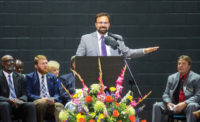Crews from Earth Tech, Land of Lakes, Fla., had to work around the piles to install a system of 3,250 "stone" columns, 3.5 ft in diameter and 30 ft deep, that support concrete equipment pads, says Power. It was more complicated than expected because "the as-builts weren't quite right," he adds.
Stone columns, which are made from coarse aggregate, are less expensive and faster to install than other soil improvement methods. They also simplify installation of underground piping and duct banks because contractors can dig through them, according to Zachry.
Using a drill, crews injected water into each column location to displace the soil to the necessary depth. As crews withdrew each probe, they added aggregate. The columns contain a total of 48,000 tons of aggregate.
A World's First
For Cape Canaveral and the other two plant modernizations, FPL is using a combination of Toshiba steam turbines, Siemens combustion gas turbines and Nooter/Ericksen heat-recovery steam generators for the combined-cycle configuration.
FPL plans to use three Siemens units at each of its three modernized plants. The units were still undergoing testing in Germany when the Cape project started.
The turbines were of special concern to FPL and Zachry because the project is using the first-ever units to roll out of the manufacturer's plant in Germany. While many try to avoid low serial numbers for plant equipment, FPL had simple reasons for choosing the Siemens units and serial numbers one through nine.
"We were looking for British thermal units, heat rate and efficiency. Siemens showed us we could achieve those goals with this technology," says Donahue. "They're very high efficiency, and very high output."
The units are the most efficient gas turbines of their kind, according to Siemens. They are the first to achieve a combined-cycle net-efficiency rate of over 60%, says Andrew Coulton, Siemens' project manager for Cape Canaveral. They also offer reduced emissions—and reduced costs—per produced kWh.
The Cape installation was helped by the proximity of Siemens' Orlando office about 30 miles from the plant. "We had the opportunity to get the folks who probably normally wouldn't be able to come over [to a project] do face-to-face visits," FPL's Donahue says.
Siemens personnel were often on site 24/7 during the installation process, adds Zachry's Power.
"The complexities and challenges during project execution with a first-of-its-kind unit are always going to be significantly higher than with a mature unit," Coulton adds. "The project team did an amazing job identifying potential issues and were able to identify and resolve issues before they became critical."
Power, a veteran of similar projects, says he is impressed with the new Siemens technology. "I was amazed when we first cranked it how smooth it came up," he says. "It's running well."
The timing of equipment installation is always a top concern, say both Donahue and Power. But on this project, at least, the team was able to get the work done ahead of schedule for all plant equipment.
The bottom line, says Donahue, is that the equipment makers "delivered when they said they would."
Lessened Marine Impacts
In addition to reducing air pollutants, the plant will reduce negative impacts on marine life.












Post a comment to this article
Report Abusive Comment